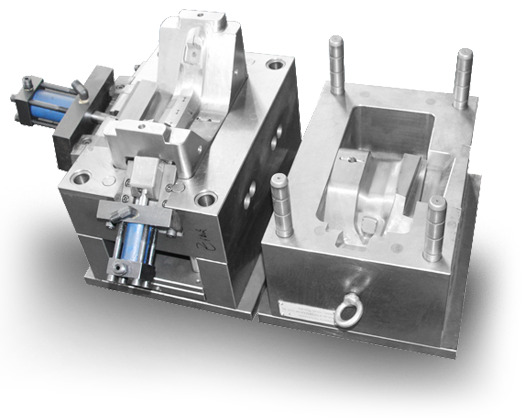If these problems occur in CNC machining, how to deal with them?
2020-03-28I encountered some abnormal conditions during the CNC processing. If I should deal with it, now I will share it with everyone ~~
First, the workpiece is overcut:
the reason:
1, the knife, the strength of the tool is not too long or too small. Causes the tool to bounce.
2. Improper operation by the operator.
3. Uneven cutting allowance. (Eg: 0.5 on the side of the surface and 0.15 on the bottom)
4. Improper cutting parameters (such as too large tolerance, too fast SF setting, etc.).
memperbaiki:
1. Use the knife principle: it can be big or small, short or long.
2. Add a clearing angle program, the remaining amount should be as uniform as possible, (the remaining amount on the side and the bottom should be consistent).
3. Reasonably adjust the cutting parameters and round the corners with large margins.
4. Using the SF function of the machine tool, the operator fine-tunes the speed to achieve the best cutting effect.
Two points:
alasannya:
1. The operator is inaccurate during manual operation and the manual operation is incorrect.
2. There are burrs around the mold.
3, the sub-rod is magnetic.
4. The four sides of the mold are not vertical.
memperbaiki:
1. Manual operation should be carefully checked repeatedly, and the division should be at the same point and the same height.
2. Use a stone or file to remove the burr around the mold, and then wipe it clean with a rag. Finally, confirm by hand.
3. Demagnetize the centrifugal rod before dividing the mold. (Ceramic centrifugal rod or other can be used).
4. Calibrate and check whether the four sides of the mold are vertical. (The verticality error needs to be reviewed with the fitter).
Three. Knife:
alasannya:
1. The operator is inaccurate during manual operation and the manual operation is incorrect.
2. The tool is incorrectly clamped.
3. The blade on the flying knife is wrong (the flying knife itself has a certain error).
4. There is an error between R knife, flat bottom knife and flying knife.
memperbaiki:
1. Manual operation should be carefully checked repeatedly, and the knife setting should be at the same point as much as possible.
2. When the tool is clamped, use a blow gun to clean it or wipe it with a rag.
3. Bilah boleh digunakan apabila bilah pada pisau terbang perlu mengukur batang dan permukaan bawah.
4. Pisahkan prosedur penetapan alat untuk mengelakkan kesalahan antara pisau R dan pisau rata.
D. Collider-Programming:
alasannya:
1. Ketinggian keselamatan tidak mencukupi atau tidak diatur (pisau atau cengkeram memukul benda kerja ketika memberi makan cepat G00).
2. Alat dalam senarai program ditulis dengan tidak betul dengan alat program yang sebenarnya.
3. Panjang alat (panjang tepi) pada senarai program dan kedalaman pemesinan sebenar ditulis dengan tidak betul.
4. Nombor akses paksi Z kedalaman dan nombor akses paksi Z sebenar dalam senarai program ditulis dengan tidak betul.
5. Koordinat ditetapkan dengan tidak betul semasa pengaturcaraan.
memperbaiki:
1. Pengukuran ketinggian bahan kerja yang tepat juga memastikan bahawa ketinggian yang selamat berada di atas benda kerja.
2. Alat dalam senarai program mesti sesuai dengan alat program yang sebenarnya (sejauh mungkin, gunakan senarai program automatik atau gambar untuk menunjukkan senarai program).
3. Ukur kedalaman pemesinan sebenar pada benda kerja, tulis dengan jelas panjang alat dan panjang bilah pada helaian program (umumnya panjang pemegang alat adalah 2-3MM lebih tinggi daripada benda kerja, dan penghindaran tepi bilah adalah 0.5-1.0MM) .
4. Ambil nombor paksi-Z sebenar pada benda kerja dan tulis dengan jelas pada senarai program. (Operasi ini umumnya ditulis secara manual dan diperiksa berulang kali).
V. Collider-Operator:
alasannya:
1. Wrong Z axis tool setting.
2. The number of hits and the number of operations are incorrect (such as: single-sided access without a radius of infeed, etc.).
3. Use the wrong knife (such as D4 knife and D10 knife for processing).
4. The program goes wrong (eg A7.NC goes A9.NC).
5. The handwheel is shaken in the wrong direction during manual operation.
6. Press the wrong direction during manual rapid feed (for example: -X press + X).
memperbaiki:
1, the depth Z axis tool setting must pay attention to where the tool setting is. (Bottom, top, analysis, etc.).
2. Repeat the check after the number of hits and operations are completed.
3, when clamping the tool, repeatedly check with the program list and the program before loading.
4. The program should go in order one by one.
5. In manual operation, the operator should strengthen the proficiency of the machine tool himself.
6. In the manual rapid movement, the Z axis can be raised above the workpiece to move.
Six. Surface accuracy:
alasannya:
1. The cutting parameters are unreasonable, and the surface of the workpiece surface is rough.
2. The cutting edge of the tool is not sharp.
3, the tool clamping is too long, the blade edge is too long.
4, chip removal, air blowing, oil flushing is not good.
5. Program the cutting method, (you can consider walking milling as far as possible).
6. The workpiece has burrs.
memperbaiki:
1. Cutting parameters, tolerances, allowances, and speed feed settings should be reasonable.
2. The cutter requires the operator to check from time to time and change it from time to time.
3. Pengendali diminta mengepit sesingkat mungkin ketika mengepit alat, dan pisau tidak boleh terlalu lama untuk menghindari pengosongan.
4. Untuk pemotongan pisau rata, pisau R, pisau hidung bulat, pengaturan suapan kelajuan haruslah wajar.
5. Bahan kerja mempunyai burr: berkaitan langsung dengan alat mesin, alat pemotong, dan kaedah pemotongan kami. Oleh itu, kita perlu memahami prestasi alat mesin, dan menebus burr.





